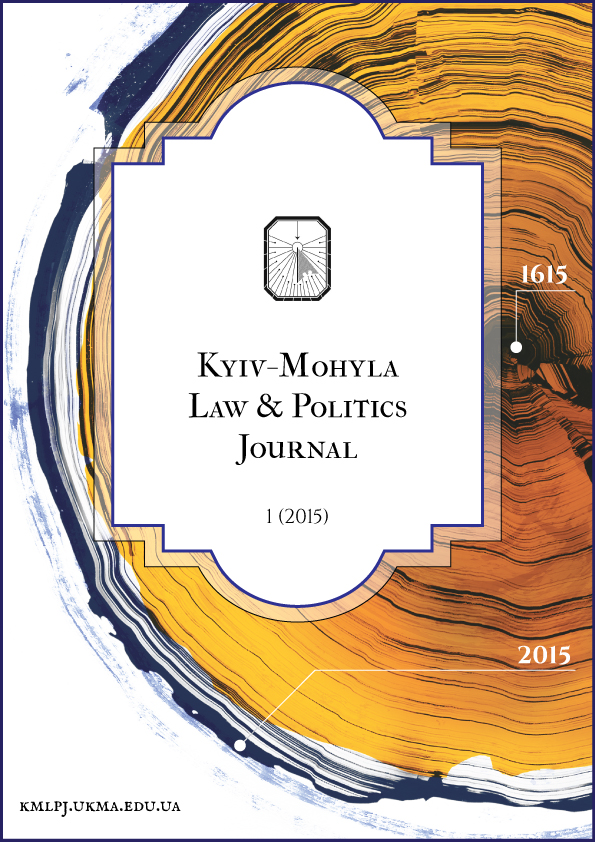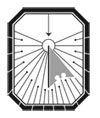The Regional Level of Ukraine’s Party System in 2005–2012
DOI:
https://doi.org/10.18523/kmlpj52655.2015-1.63-81Keywords:
Ukraine, regions, party system, party politics, congruenceAbstract
This article describes the results of a regional-level study of Ukrainian political parties’ interactions. The study sought to identify the congruence or incongruence of the party affiliationof the regional executives and the heads of regional assemblies across Ukraine when Ukraine’s democratic performance rose and fell. The study found that when democratic performance rose, so did regional-level, party-affiliation incongruence, with the greatest ideological incongruence occurring in regions with special institutional arrangements, such as Kyiv and Sevastopol. When
Ukraine’s democratic performance fell, the number of ideologically congruent regions rose. These shifts occurred because a decline in democratic performance leaves little institutional room for statewide opposition, and the main competitors of the ruling party in regional bodies of power are non-statewide parties and blocs. Thus, this article argues that political cleavages in a regionally diverse post-communist state do not automatically mirror the statewide party competition.
References
- Barrington, Lowell, and Erik Herron. “One Ukraine or Many? Regionalism in Ukraine and its Political Consequences.” Nationalities Papers 32.1 (2004): 53–86. https://doi.org/10.1080/0090599042000186179
- Birch, Sarah. Electoral Systems and Political Transformation in Post-Communist Europe. New York: Palgrave Macmillan, 2003.
- Christensen, Robert et al. “The Ukrainian Orange Revolution Brought More than a New President: What Kind of Democracy Will the Institutional Changes Bring?” Communist and Post-Communist Studies 38.2 (2005): 207–30. https://doi.org/10.1016/j.postcomstud.2005.03.006
- Copsey, Nathaniel. “The Ukrainian Parliamentary Elections of 2006.” Representation 42.4 (2006): 333–45. https://doi.org/10.1080/00344890600951908
- Copsey, Nathaniel. “The Ukrainian Parliamentary Elections of 2007.” Journal of Communist Studies and Transition Politics 24.2 (2008): 297–309. https://doi.org/10.1080/13523270802003129
- D’Anieri, Paul. “Ethnic Tensions and State Strategies: Understanding the Survival of the Ukrainian State.” Journal of Communist Studies and Transition Politics 23.1 (2007): 4–29. https://doi.org/10.1080/13523270701194896
- Database. “Political Elites of Ukrainian Regions.” Accessed May 19, 2013. http://src-h.slav.hokudai.ac.jp/ukrregions/titulna.html.
- Hale, Henry. “The Uses of Divided Power.” Journal of Democracy 21.3 (2010): 84–98.
- Herron, Erik. “The Parliamentary Election in Ukraine, September 2007.” Electoral Studies 27 (2008): 547–77. https://doi.org/10.1016/j.electstud.2008.02.011
- Hesli, Vicky. “The 2006 Parliamentary Election in Ukraine.” Electoral Studies 26 (2007): 507–33. https://doi.org/10.1016/j.electstud.2006.10.014
- Jeffery, Charlie, and Dan Hough. “Understanding Post-Devolution Elections in Scotland and Wales in Comparative Perspective.” Party Politics 15.2 (2009): 219–40. https://doi.org/10.1177/1354068808099982
- Katchanovski, Ivan. “Regional Political Divisions in Ukraine in 1991–2006.” Nationalities Papers 34. 5 (2006): 507–32. https://doi.org/10.1080/00905990600952939
- Matsuzato, Kimitaka. “All Kuchma’s Men: The Reshuffling of Ukrainian Governors and the Presidential Election of 1999.” Post-Soviet Geography and Economics 42.6 (2001): 416–39. https://doi.org/10.1080/10889388.2001.10641179
- Matsuzato, Kimitaka. “From Communist Boss Politics to Post-Communist Caciquismo: The Meso-Elite and Meso-Governments in Post-Communist Countries.” Communist and Post-Communist Studies 34 (2001): 175–201. https://doi.org/10.1016/s0967-067x(01)00007-1
- Matsuzato, Kimitaka. “From Ethno-Bonapartism to Centralized Caciquismo: Characteristics and Origins of the Tatarstan Political Regime, 1990–2000.” Journal of Communist Studies and Transition Politics 17.4 (2001): 43–77. https://doi.org/10.1080/714003590
- Meleshevich, Andrey. Party Systems in Post-soviet Countries: A Comparative Study of Political Institutionalization in the Baltic States, Russia and Ukraine. Basingstoke: Palgrave Macmillan, 2007. https://doi.org/10.1177/13540688100160040603
- Melvin, Hinich, Khmelko, Valeri, and Peter Ordeshook. “A Spatial Analysis of Ukraine’s 1998 Parliamentary Elections.” Post-Soviet Affairs 15.2 (1999): 149–85. https://doi.org/10.1080/1060586x.1999.10641468
- Razumkov Centre. “Party System in Ukraine.” Accessed January 18, 2013. http://razumkov.org.ua/ukr/journal.php?y=2010&cat=156.
- Ross, Cameron. “Regional Elections and Electoral Authoritarianism in Russia.” Europe-Asia Studies 63.4 (2011): 641–62. https://doi.org/10.1080/09668136.2011.566428
- Ross, Cameron. “The Rise and Fall of Political Parties in Russia’s Regional Assemblies.” Europe-Asia Studies 63. 3 (2011): 429–48. https://doi.org/10.1080/09668136.2011.557535
- Riabchuk, Mykola. “Dvi Ukrainy.” [“Two Ukraines.”] Krytyka 10 (2001). Accessed March 20, 2013. http://spilka.us.org.ua/library/riabczuk_kr.html.
- Sartori, Giovanni. Parties and Party Systems: A Framework for Analysis. Cambridge: Cambridge University Press, 1976.
- Sasse, Gwendolyn. “The ‘New Ukraine’: A State of Regions.” In Ethnicity and Territory in the Former Soviet Union: Regions in the Conflict, edited by Gwendolyn Sasse and James Hugh, 69 – 100. London: Frank Cass Publishers, 2001. https://doi.org/10.4324/9780203045732-3
- Schneider, Carsten Q. “Issues in Measuring Political Regimes.” DISC Working Paper Series 12 (2010). Accessed April 15, 2013. https://disc.ceu.hu/sites/default/files/field_attachment/page/node-3320/discwp12a_0.pdf.
- Situations Modeling Agency. “Hore Peremozhenym.” [“Grief to the Defeated.”] The Agency’s report at the round table on the 2010 regional elections. November 11, 2010.
- Thorlakson, Lori. “Patterns of Party Integration, Influence and Autonomy in Seven Federations.” Party Politics 15. 2 (2009): 157–77. https://doi.org/10.1177/1354068808099979
- Thorlakson, Lori. “An Institutional Explanation of Party System Congruence: Evidence from Six Federations.” European Journal of Political Research 46 (2007): 69–95. https://doi.org/10.1111/j.1475-6765.2006.00647.x
- Umland, Andreas. “Ukraine’s Party System in Transition? The Raise of the Radically Right-Wing All-Ukrainian Association ‘Svoboda’.” Geopolitika. Accessed March 13, 2013. http://www.geopolitika.lt/?artc=4429.
- Wilson, Andrew, and Sarah Birch. “Voting Stability, Political Gridlock: Ukraine’s 1998 Parliamentary Elections.” Europe-Asia Studies 51. 6 (1999): 1039–68. https://doi.org/10.1080/09668139998624
- Wolczuk, Kataryna. “Catching up with ‘Europe’? Constitutional Debates on the Territorial-Administrative Model in Independent Ukraine.” Regional and Federal Studies 12.2 (2002): 65–88. https://doi.org/10.1080/714004750
Downloads
How to Cite
Issue
Section
License
Copyright (c) 2016 Valentyna Romanova

This work is licensed under a Creative Commons Attribution 4.0 International License.
Kyiv-Mohyla Law and Politics Journal provides free access to original research without restriction barriers (i.e. subscription fees, licensing fees etc.).
Unless otherwise indicated, content is licensed under the Creative Commons Attribution 4.0 International (CC BY 4.0) license, which means you are free to:
distribute, remix, tweak, and build upon your work, even commercially
...provided that any use is made with attribution to author(s) and Kyiv-Mohyla Law and Politics Journal.
The copyright in the article or any other submission to Kyiv-Mohyla Law and Politics Journal shall remain with the author(s).
The journal allows the author(s) to hold the copyright without restrictions and will retain publishing rights without restrictions.





